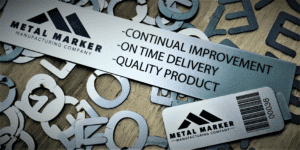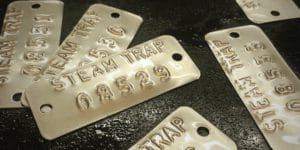Industries of all types rely on safety identification to keep workers safe and prevent accidents from occurring. For many industries, this means prominently marking safety information with data code plates.
Applications
What Are Code Plates Used for?
The “code” in the term “code plates” typically refers to meeting a set of standards or regulations. This is often an element of industrial safety requirements.
The plates are mandated by OSHA, ANSI, and other industry regulators.
CSC Plates
When it comes to international shipping, data code plates are essential.
The Convention for Safe Containers has set in place legislation which mandates the use of metal code plates on every shipping container sent internationally.
The CSC plates are affixed to the sturdy crates to provide a standardized information protocol. This makes navigating various ports and international shipping significantly easier for all parties involved.
These plates are also often combined with other relevant information regarding the container (i.e. weight, size, and manufacturer).
Elevator Data Code Plates
Another example of a safety code requirement, elevators must be marked with code plates. This is set forth by the American Society of Mechanical Engineers.
According to the ASME A17.1 guidelines, the elevator plate must be marked with up-to-date information, and must be in plain view for inspection.
Elevator data code plates provide servicers and first responders with the information they need.
In addition, elevator interiors are also marked with important safety information. This can include capacity limits, emergency directions, etc.
Inspection Tags
One of the most important tasks for maintaining safety in an industrial environment is regular periodic inspections. This helps ensure that equipment and infrastructure is performing optimally.
Proper inspections serve to prevent accidents before they occur. This helps protect workers from harm, as well as equipment and machinery from being damaged. For example, forklifts must be marked with a data plate.
Data code plates make inspections as easy as possible by providing quality information to servicers.
Industries
Industries of many varieties utilize code plates to mark important safety warnings and other information.
A few common examples include:
- Manufacturing
- Telecommunications
- Construction
- Energy
- Oil & Gas
- Shipping
- Many More
Marking Processes
Photo Anodization
Photo anodization is one of the most common processes used for marking data code plates.
This process embeds a fully custom design underneath a protective anodized layer. This allows for code plates with any type of information or logo. Many organizations utilize this marking method to add barcodes, QR codes, and data matrix codes.

Since data plates are often used for safety applications, including a safety or warning logo is not a problem.
Customization is great, but not if it means losing durability. Photo anodized code plates offer both high customization, without sacrificing longevity.
These nameplates last upwards of 20+ years, even when exposed to weather, wear and more.
Embossing/Stamping
If photo anodizing is not right for your application, there are other durable marking methods.
Depending on what information will need to be marked, the plates can be embossed or stamped.

Stamping presses the information into the metal, leaving a long-lasting recessed impression.
The embossing process produces a durable raised design, which is legible even when painted over. This makes it a great option for tough industrial settings.
Since data code plates are often used to comply with industry requirements, make sure the marking process you select matches any specific guidelines you are attempting to meet.
Wrap-Up
Data code plates are a vital component of maintaining safety in industrial type environments. They are mandated by many workplace safety organizations as they are an easy but effective method for preventing injuries and accidents.